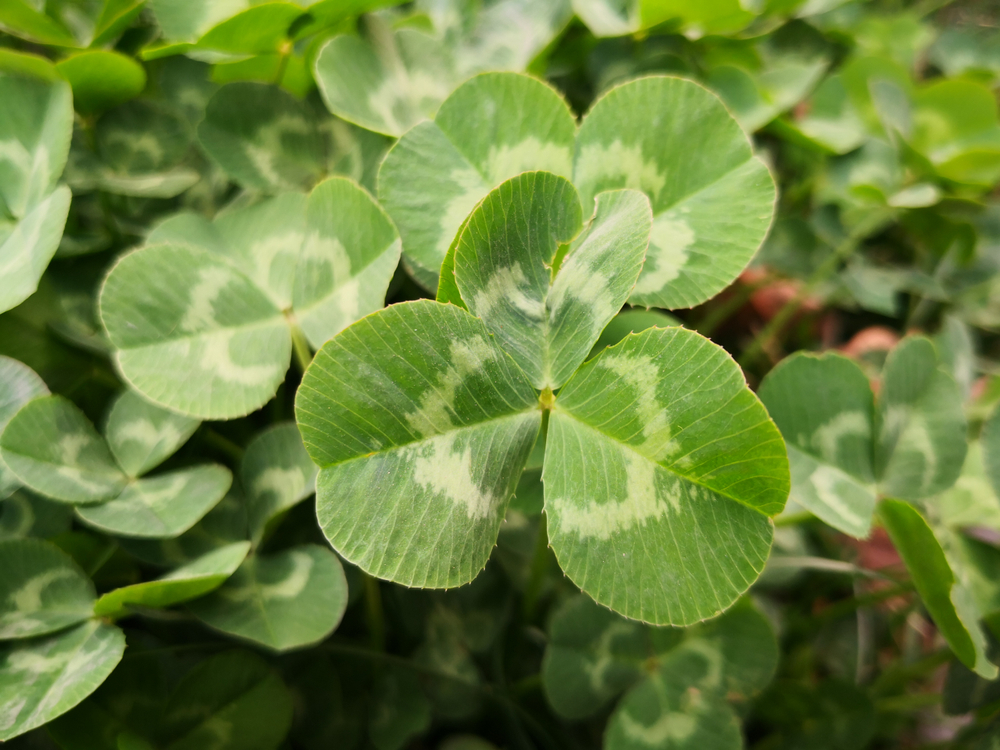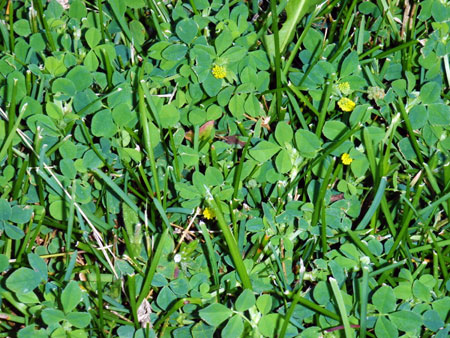Understanding the Difference Between Clover and Lawn Weeds
Clover is a common element in many lawns, often appreciated for its ability to fix nitrogen in the soil and contribute to a greener, healthier lawn. However, there are certain lawn weeds that may resemble clover, causing confusion and potentially leading to ineffective lawn care strategies. These weeds often have similar three-leaflet patterns, making it challenging for homeowners to differentiate between the two. Accurate identification is crucial, as managing clover and lawn weeds requires different approaches.
Common Lawn Weeds That Look Like Clover: An In-Depth Look
Lawn weeds that resemble clover can be a common sight in many lawns, causing confusion and potentially hindering effective lawn care strategies. These weeds often have similar three-leaflet patterns, making it challenging for homeowners to differentiate between clover and undesirable weeds. Here are some of the most common lawn weeds that may be mistaken for clover:
- Black Medic (Medicago lupulina): This annual weed has small, round leaflets with a darker green hue than clover. Black medic also produces yellow flowers and grows in nutrient-poor soils, often indicating lawn care issues.
- Hop Clover (Trifolium campestre): Hop clover is a perennial weed that closely resembles clover, with its three-leaflet pattern and white or pink flowers. However, hop clover has a more invasive growth habit and can be difficult to control due to its extensive root system.
- Oxalis (Oxalis spp.): Often mistaken for clover, oxalis is a troublesome lawn weed with a variety of species. Its heart-shaped leaflets and small yellow or white flowers can be confused with clover, but oxalis regrows from small fragments of its bulbs, making it challenging to control.
Correctly identifying these lawn weeds is crucial for effective lawn care and maintenance. By understanding the unique characteristics of each weed, homeowners can implement targeted management strategies to maintain a healthy, thriving lawn.
Black Medic: A Clover Look-Alike
Black medic (Medicago lupulina) is a common lawn weed that closely resembles clover, often leading to confusion among homeowners. This annual weed features small, round leaflets with a darker green hue than clover. Black medic also produces yellow flowers, which can be mistaken for clover blooms. It typically thrives in nutrient-poor soils, often indicating lawn care issues, such as insufficient fertilization or poor soil health.
Black medic has an extensive root system, allowing it to spread quickly and become invasive in lawns. Its growth patterns can lead to a patchy, uneven lawn appearance, which may be undesirable for homeowners. In addition, black medic can outcompete desired grass species for resources, further contributing to lawn health issues.
To effectively manage black medic, it is essential to maintain proper lawn care practices. Regular mowing, fertilization, and watering can help promote a healthy, thriving lawn that is less susceptible to black medic infestations. In addition, core aeration and overseeding can improve soil health and reduce compacted areas, making it more challenging for black medic to establish.
When dealing with an existing black medic infestation, selective herbicides may be necessary. These products target specific weeds while minimizing damage to desired grass species. Always follow the manufacturer’s instructions and guidelines when using herbicides to ensure safe and effective application.
Hop Clover: Another Clover Imposter
Hop clover (Trifolium campestre) is another lawn weed that closely resembles clover, often causing confusion among homeowners. This perennial weed has a three-leaflet pattern and white or pink flowers, making it difficult to distinguish from clover at first glance. However, hop clover has a more invasive growth habit and can be challenging to control due to its extensive root system.
Hop clover thrives in various soil conditions, including well-drained and compacted soils. Its growth patterns can lead to a patchy, uneven lawn appearance, which may be undesirable for homeowners. In addition, hop clover can outcompete desired grass species for resources, further contributing to lawn health issues.
To effectively manage hop clover, it is essential to maintain proper lawn care practices. Regular mowing, fertilization, and watering can help promote a healthy, thriving lawn that is less susceptible to hop clover infestations. In addition, core aeration and overseeding can improve soil health and reduce compacted areas, making it more challenging for hop clover to establish.
When dealing with an existing hop clover infestation, selective herbicides may be necessary. These products target specific weeds while minimizing damage to desired grass species. Always follow the manufacturer’s instructions and guidelines when using herbicides to ensure safe and effective application.
It is crucial to differentiate hop clover from clover to implement appropriate lawn care strategies. By accurately identifying hop clover, homeowners can take targeted action to manage this invasive weed and maintain a healthy, thriving lawn.
Oxalis: A Troublesome Clover Look-Alike
Oxalis (Oxalis spp.) is a lawn weed that is often mistaken for clover due to its similar three-leaflet pattern. However, oxalis has heart-shaped leaflets and small yellow or white flowers, setting it apart from clover. This perennial weed can be challenging to control, as it has the ability to regrow from small fragments of its bulbs.
Oxalis thrives in various soil conditions, including well-drained and shaded areas. Its growth patterns can lead to a patchy, uneven lawn appearance, which may be undesirable for homeowners. In addition, oxalis can outcompete desired grass species for resources, further contributing to lawn health issues.
To effectively manage oxalis, it is essential to maintain proper lawn care practices. Regular mowing, fertilization, and watering can help promote a healthy, thriving lawn that is less susceptible to oxalis infestations. In addition, core aeration and overseeding can improve soil health and reduce compacted areas, making it more challenging for oxalis to establish.
When dealing with an existing oxalis infestation, selective herbicides may be necessary. These products target specific weeds while minimizing damage to desired grass species. Always follow the manufacturer’s instructions and guidelines when using herbicides to ensure safe and effective application.
Due to oxalis’s ability to regrow from small bulb fragments, it is crucial to remove as much of the weed as possible during management. This includes removing the bulbs and any remaining leaflets to prevent regrowth. By accurately identifying oxalis and implementing targeted management strategies, homeowners can maintain a healthy, thriving lawn.
How to Differentiate Clover from Lawn Weeds: Practical Tips
Accurately identifying lawn weeds that resemble clover is crucial for effective lawn care and maintenance. By employing practical differentiation methods, homeowners can ensure they are addressing the correct issues and implementing appropriate management strategies. Here are some tips for distinguishing clover from look-alike lawn weeds:
- Leaflet Shape: Examine the leaflet shape of the plant in question. Clover has rounded or oval-shaped leaflets, while black medic has more elongated, elliptical leaflets. Hop clover has a more distinct, asymmetrical leaflet shape, and oxalis has heart-shaped leaflets.
- Stem Color: Inspect the color of the plant’s stems. Clover stems are typically green, while black medic stems have a reddish tint. Hop clover stems are often hairy, while oxalis stems are smooth.
- Flower Structure: Analyze the flower structure of the plant. Clover has small, white or pink flowers with a distinct “ball” shape. Black medic flowers are yellow and clustered in elongated spikes, while hop clover flowers are white or pink and arranged in rounded clusters. Oxalis flowers are small and yellow, with five petals, and are borne on long stems.
By employing these practical differentiation methods, homeowners can accurately identify lawn weeds that resemble clover and take appropriate action to maintain a healthy, thriving lawn. Correct identification is the foundation for effective lawn care and management, ensuring that resources are used efficiently and that desired outcomes are achieved.
Managing Lawn Weeds That Resemble Clover: Best Practices
Effectively managing lawn weeds that look like clover requires a strategic approach that combines proper lawn care, fertilization, and mowing techniques. By following these best practices, homeowners can maintain a healthy, thriving lawn and minimize the presence of undesirable weeds:
- Proper Lawn Care: Implementing a consistent lawn care routine is essential for maintaining a healthy lawn and minimizing the presence of weeds. This includes regular watering, mowing, and fertilization, as well as addressing any lawn care issues, such as soil compaction or poor drainage.
- Fertilization: Proper fertilization is crucial for promoting healthy grass growth and minimizing the presence of weeds. A balanced fertilizer can help provide essential nutrients, such as nitrogen, phosphorus, and potassium, to support strong root development and healthy foliage. Always follow the manufacturer’s instructions and guidelines when applying fertilizers to ensure safe and effective use.
- Mowing Techniques: Mowing at the appropriate height and frequency can help promote healthy grass growth and minimize the presence of weeds. Taller grass blades can help shade the soil, reducing the likelihood of weed seed germination. In addition, regularly removing weed flowers before they go to seed can help prevent the spread of undesirable weeds.
- Selective Herbicides: In some cases, the use of selective herbicides may be necessary to control specific lawn weeds that resemble clover. These products target specific weeds while minimizing damage to desired grass species. Always follow the manufacturer’s instructions and guidelines when using herbicides to ensure safe and effective application.
By employing these best practices, homeowners can effectively manage lawn weeds that resemble clover and maintain a healthy, thriving lawn. Regular lawn maintenance, such as aeration, overseeding, and topdressing, can also help promote healthy grass growth and minimize the presence of invasive weeds.
Preventing Lawn Weeds That Imitate Clover: Long-Term Strategies
Preventing the growth and spread of lawn weeds that resemble clover is crucial for maintaining a healthy, thriving lawn. By employing long-term strategies, such as regular lawn maintenance, homeowners can minimize the presence of invasive weeds and promote strong, vigorous grass growth. Here are some key long-term strategies for preventing lawn weeds that look like clover:
- Aeration: Regularly aerating the lawn can help alleviate soil compaction, improve soil structure, and promote healthy root growth. This, in turn, can help create a dense, vigorous lawn that is less susceptible to weed infestations.
- Overseeding: Overseeding the lawn with a high-quality grass seed mix can help thicken the turf and create a dense, healthy lawn. A thicker lawn can help prevent the establishment and spread of weeds, including those that resemble clover.
- Topdressing: Topdressing the lawn with a layer of organic matter, such as compost or well-rotted manure, can help improve soil structure, fertility, and water-holding capacity. This can help promote healthy grass growth and minimize the presence of invasive weeds.
- Proper Watering and Mowing: Implementing a consistent watering and mowing routine can help promote healthy grass growth and minimize the presence of weeds. Watering deeply and infrequently can help encourage deep root growth, while mowing at the appropriate height and frequency can help promote a dense, vigorous lawn.
By employing these long-term strategies, homeowners can create a healthy, thriving lawn that is less susceptible to invasive weeds, including those that closely resemble clover. A well-maintained lawn is the best defense against weeds, providing a dense, vigorous turf that can outcompete and minimize the presence of undesirable weeds.








:max_bytes(150000):strip_icc()/how-plant-clover-lawn-4858751-08-a4ed717ebe3f429f931f066e09996783.jpg)